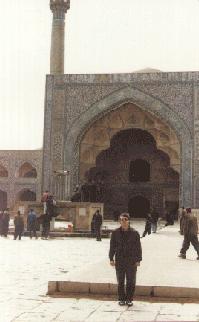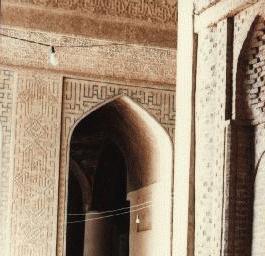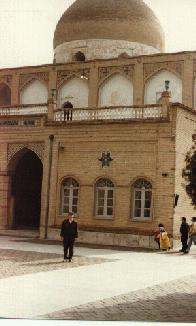TasAvir-e Iran
Khoosh Amadid!
Below are some photographs from my trip to Iran in 1995. I am an
American born citizen and traveled to Iran on an
American passport. Yes, the Iranian government does grant visas to
Americans! Iran is a beautiful country full of history and culture.
My experience was very good; I was well received and well
treated by many kind and hospitable people in Iran. If you find
the opportunity to visit Iran you will not be disappointed. Check
out the Lonely
Planet travel guide for comments of other travelers to Iran.
The first step in traveling to Iran is securing a visa. As you
may know, there is no Iranian embassy in the United States.
However, there is an Interests
Section in Washington D.C. which can assist you in obtaining a
visa. They do not have authority to issue visas directly so your
application will first be sent to Tehran for review by the Foreign
Ministry. After receiving approval from Tehran the Interests
Section will then stamp your passport. The staff at the Interests
Section are very helpful although usually very busy. If you go
there in person, be prepared to arrive early in the day and wait
several hours. Interestingly, as part of the agreement with the
U.S. which established the Interests Section, the staff are all
either U.S. citizens, themselves, or they are legal permanent U.S.
residents.
 This is a picture of the
Mausoleum of Ayatollah Ruhollah Khomeini which is located south of Tehran near
the Behesht-e Zahra cemetery where martyrs from the defense of Iran
against Saddam Hussein are buried. The Mausoleum is very beautiful
at night. The dome and minarets are well lit and can be seen for
many miles. In the darkness the only competing lights are from the
flares of the refineries a few miles away.
This is a picture of the
Mausoleum of Ayatollah Ruhollah Khomeini which is located south of Tehran near
the Behesht-e Zahra cemetery where martyrs from the defense of Iran
against Saddam Hussein are buried. The Mausoleum is very beautiful
at night. The dome and minarets are well lit and can be seen for
many miles. In the darkness the only competing lights are from the
flares of the refineries a few miles away.
One enters the mausoleum from one of two entrances (one for men
and one for women). There is a room to leave one's shoes and then
one enters the large marble tiled main area. The tombs of
Khomeini and his son are located in the very center of the room.
Carpets are laid out on the floor for migrants and poor travelers
to spend the night. The structure is quite modern with painted
steel columns and overhead lights strung from a steel framework
looking much like a modern warehouse. Quite different from the
impression one gets from the fabulous exterior.
Outside there are kiosks where one may purchase refreshments, mementos, copies of various
texts including Khomeini's writings. Surprisingly (at least to me), one may also purchase cassette tapes of
popular music and there are coin operated amusements for children.
 This is a picture of the Hosseiniyeh-e Irshad located in
Tehran.
This is a picture of the Hosseiniyeh-e Irshad located in
Tehran.
The following photographs are from Isfahan, one of the former
capitols of Iran which reached its greatest prominence under the Safavi kings. These pictures are not terribly good for various reasons including the fact that it was a cold, rainy day when I arrived.
 This is a picture of the Si-o-Seh Pol over the Ziyandeh Rud. The bridge is named for the 33 arches which comprise the structure. This is one of several bridges across the Ziyandeh Rud river which cuts through the city.
This is a picture of the Si-o-Seh Pol over the Ziyandeh Rud. The bridge is named for the 33 arches which comprise the structure. This is one of several bridges across the Ziyandeh Rud river which cuts through the city.
 This is a picture
inside the Masjed-e Imam (aka Masjed-e Shah) which is the most
prominent mosque on the Naqsh-e JahAn, a large open square built by
the Safavis. The masjed is magnificently covered with multicolored
tiles typical of the work from the Safavi period. Behind the
photographer is a dome constructed in such a way that it reflects
and seemingly magnifies sound to a point in the center of the
room.
This is a picture
inside the Masjed-e Imam (aka Masjed-e Shah) which is the most
prominent mosque on the Naqsh-e JahAn, a large open square built by
the Safavis. The masjed is magnificently covered with multicolored
tiles typical of the work from the Safavi period. Behind the
photographer is a dome constructed in such a way that it reflects
and seemingly magnifies sound to a point in the center of the
room.
 This is a shot of the center of the Masjed-e JAme. Although tiled during the reign of the Safavis, this masjed predates the Masjed-e Imam by several hundred years, constructed during the reign of the Saljuqi kings.
This is a shot of the center of the Masjed-e JAme. Although tiled during the reign of the Safavis, this masjed predates the Masjed-e Imam by several hundred years, constructed during the reign of the Saljuqi kings.
 Surrounding the
central open court are myriad vaults inscribed meticulously with
caligraphic script. Although plain in color and appearance, the
fine engraving and detailed brickwork are testament to the immense
labor expended in constructing this masjed. The masjed suffered
damage during the Iraq/Iran war when Saddam's pilots dropped bombs
on the site.
Surrounding the
central open court are myriad vaults inscribed meticulously with
caligraphic script. Although plain in color and appearance, the
fine engraving and detailed brickwork are testament to the immense
labor expended in constructing this masjed. The masjed suffered
damage during the Iraq/Iran war when Saddam's pilots dropped bombs
on the site.
You may have noted the background tile pattern
which I created for this page which is inspired by the work in this
and other masAjed (mosques) in Iran. The "stars" in the background
contain the names of Mohammad or Ali written four times
symmetrically. Outside the stars is written Allah.
 The KelisA-ye Vank is an Armenian Christian church located in the Christian sector of the city south of the Ziyandeh Rud. The facade bears a date of 1655. The Armenians in Isfahan were moved to the city during the reign of Shah Abbas. The exterior of the church appears much like a masjed (without the minarets) but the interior is covered with elaborate paintings of medieval scenes of martyrdom. Adjacent to the church is a museum housing a collection of Armenian cultural and historical items.
The KelisA-ye Vank is an Armenian Christian church located in the Christian sector of the city south of the Ziyandeh Rud. The facade bears a date of 1655. The Armenians in Isfahan were moved to the city during the reign of Shah Abbas. The exterior of the church appears much like a masjed (without the minarets) but the interior is covered with elaborate paintings of medieval scenes of martyrdom. Adjacent to the church is a museum housing a collection of Armenian cultural and historical items.
Please send your comments.


 This page has been accessed
This page has been accessed  times since 19 November 1997.
This page hosted by
times since 19 November 1997.
This page hosted by 
Get your own Free Home Page
 This is a picture of the
Mausoleum of Ayatollah Ruhollah Khomeini which is located south of Tehran near
the Behesht-e Zahra cemetery where martyrs from the defense of Iran
against Saddam Hussein are buried. The Mausoleum is very beautiful
at night. The dome and minarets are well lit and can be seen for
many miles. In the darkness the only competing lights are from the
flares of the refineries a few miles away.
This is a picture of the
Mausoleum of Ayatollah Ruhollah Khomeini which is located south of Tehran near
the Behesht-e Zahra cemetery where martyrs from the defense of Iran
against Saddam Hussein are buried. The Mausoleum is very beautiful
at night. The dome and minarets are well lit and can be seen for
many miles. In the darkness the only competing lights are from the
flares of the refineries a few miles away. This is a picture of the Hosseiniyeh-e Irshad located in
Tehran.
This is a picture of the Hosseiniyeh-e Irshad located in
Tehran.  This is a picture of the Si-o-Seh Pol over the Ziyandeh Rud. The bridge is named for the 33 arches which comprise the structure. This is one of several bridges across the Ziyandeh Rud river which cuts through the city.
This is a picture of the Si-o-Seh Pol over the Ziyandeh Rud. The bridge is named for the 33 arches which comprise the structure. This is one of several bridges across the Ziyandeh Rud river which cuts through the city.
 This is a picture
inside the Masjed-e Imam (aka Masjed-e Shah) which is the most
prominent mosque on the Naqsh-e JahAn, a large open square built by
the Safavis. The masjed is magnificently covered with multicolored
tiles typical of the work from the Safavi period. Behind the
photographer is a dome constructed in such a way that it reflects
and seemingly magnifies sound to a point in the center of the
room.
This is a picture
inside the Masjed-e Imam (aka Masjed-e Shah) which is the most
prominent mosque on the Naqsh-e JahAn, a large open square built by
the Safavis. The masjed is magnificently covered with multicolored
tiles typical of the work from the Safavi period. Behind the
photographer is a dome constructed in such a way that it reflects
and seemingly magnifies sound to a point in the center of the
room.
 This is a shot of the center of the Masjed-e JAme. Although tiled during the reign of the Safavis, this masjed predates the Masjed-e Imam by several hundred years, constructed during the reign of the Saljuqi kings.
This is a shot of the center of the Masjed-e JAme. Although tiled during the reign of the Safavis, this masjed predates the Masjed-e Imam by several hundred years, constructed during the reign of the Saljuqi kings.  Surrounding the
central open court are myriad vaults inscribed meticulously with
caligraphic script. Although plain in color and appearance, the
fine engraving and detailed brickwork are testament to the immense
labor expended in constructing this masjed. The masjed suffered
damage during the Iraq/Iran war when Saddam's pilots dropped bombs
on the site.
Surrounding the
central open court are myriad vaults inscribed meticulously with
caligraphic script. Although plain in color and appearance, the
fine engraving and detailed brickwork are testament to the immense
labor expended in constructing this masjed. The masjed suffered
damage during the Iraq/Iran war when Saddam's pilots dropped bombs
on the site. The KelisA-ye Vank is an Armenian Christian church located in the Christian sector of the city south of the Ziyandeh Rud. The facade bears a date of 1655. The Armenians in Isfahan were moved to the city during the reign of Shah Abbas. The exterior of the church appears much like a masjed (without the minarets) but the interior is covered with elaborate paintings of medieval scenes of martyrdom. Adjacent to the church is a museum housing a collection of Armenian cultural and historical items.
The KelisA-ye Vank is an Armenian Christian church located in the Christian sector of the city south of the Ziyandeh Rud. The facade bears a date of 1655. The Armenians in Isfahan were moved to the city during the reign of Shah Abbas. The exterior of the church appears much like a masjed (without the minarets) but the interior is covered with elaborate paintings of medieval scenes of martyrdom. Adjacent to the church is a museum housing a collection of Armenian cultural and historical items.


 This page has been accessed
This page has been accessed